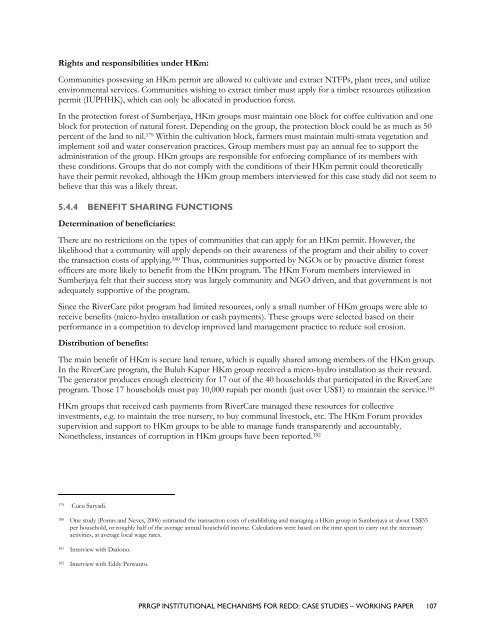Institutional Mechanisms for REDD+ - Case Studies Working Paper
Institutional Mechanisms for REDD+ - Case Studies Working Paper
Institutional Mechanisms for REDD+ - Case Studies Working Paper
Create successful ePaper yourself
Turn your PDF publications into a flip-book with our unique Google optimized e-Paper software.
Rights and responsibilities under HKm:<br />
Communities possessing an HKm permit are allowed to cultivate and extract NTFPs, plant trees, and utilize<br />
environmental services. Communities wishing to extract timber must apply <strong>for</strong> a timber resources utilization<br />
permit (IUPHHK), which can only be allocated in production <strong>for</strong>est.<br />
In the protection <strong>for</strong>est of Sumberjaya, HKm groups must maintain one block <strong>for</strong> coffee cultivation and one<br />
block <strong>for</strong> protection of natural <strong>for</strong>est. Depending on the group, the protection block could be as much as 50<br />
percent of the land to nil. 179 Within the cultivation block, farmers must maintain multi-strata vegetation and<br />
implement soil and water conservation practices. Group members must pay an annual fee to support the<br />
administration of the group. HKm groups are responsible <strong>for</strong> en<strong>for</strong>cing compliance of its members with<br />
these conditions. Groups that do not comply with the conditions of their HKm permit could theoretically<br />
have their permit revoked, although the HKm group members interviewed <strong>for</strong> this case study did not seem to<br />
believe that this was a likely threat.<br />
5.4.4 BENEFIT SHARING FUNCTIONS<br />
Determination of beneficiaries:<br />
There are no restrictions on the types of communities that can apply <strong>for</strong> an HKm permit. However, the<br />
likelihood that a community will apply depends on their awareness of the program and their ability to cover<br />
the transaction costs of applying. 180 Thus, communities supported by NGOs or by proactive district <strong>for</strong>est<br />
officers are more likely to benefit from the HKm program. The HKm Forum members interviewed in<br />
Sumberjaya felt that their success story was largely community and NGO driven, and that government is not<br />
adequately supportive of the program.<br />
Since the RiverCare pilot program had limited resources, only a small number of HKm groups were able to<br />
receive benefits (micro-hydro installation or cash payments). These groups were selected based on their<br />
per<strong>for</strong>mance in a competition to develop improved land management practice to reduce soil erosion.<br />
Distribution of benefits:<br />
The main benefit of HKm is secure land tenure, which is equally shared among members of the HKm group.<br />
In the RiverCare program, the Buluh Kapur HKm group received a micro-hydro installation as their reward.<br />
The generator produces enough electricity <strong>for</strong> 17 out of the 40 households that participated in the RiverCare<br />
program. Those 17 households must pay 10,000 rupiah per month (just over US$1) to maintain the service. 181<br />
HKm groups that received cash payments from RiverCare managed these resources <strong>for</strong> collective<br />
investments, e.g. to maintain the tree nursery, to buy communal livestock, etc. The HKm Forum provides<br />
supervision and support to HKm groups to be able to manage funds transparently and accountably.<br />
Nonetheless, instances of corruption in HKm groups have been reported. 182<br />
179 Cucu Suryadi.<br />
180 One study (Porras and Neves, 2006) estimated the transaction costs of establishing and managing a HKm group in Sumberjaya at about US$55<br />
per household, or roughly half of the average annual household income. Calculations were based on the time spent to carry out the necessary<br />
activities, at average local wage rates.<br />
181 Interview with Dariono.<br />
182 Interview with Eddy Perwanto.<br />
PRRGP INSTITUTIONAL MECHANISMS FOR REDD: CASE STUDIES – WORKING PAPER 107

















